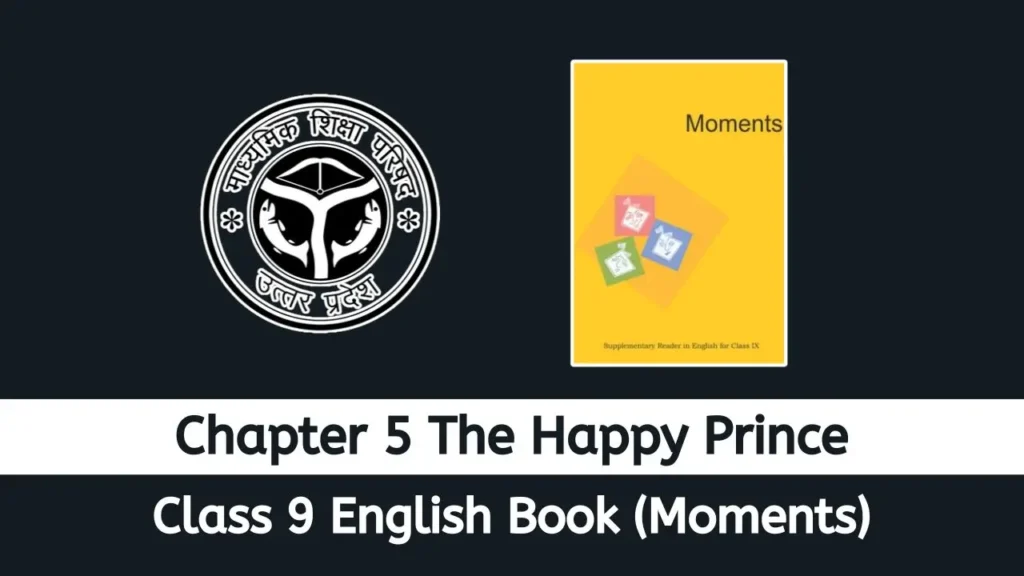Are you searching for UP Board class 9 English Moments chapter 5 solutions? If yes, then you are at the right place. On this page, we have presented you with the complete question answer and solution of chapter 5 – “The Happy Prince”.
Chapter 5 of the UP Board Class 9 English Moments book – “The Happy Prince,” is a touching story by Oscar Wilde that explores themes of compassion, sacrifice, and the true meaning of happiness. The story revolves around a majestic statue of a prince, once joyful in life but now deeply saddened by the suffering and poverty he observes in the city below.

UP Board Class 9 English Moments Chapter 5 Solutions
| Subject | English |
| Class | 9th |
| Chapter | The Happy Prince |
| Author | Oscar Wilde |
| Board | UP Board |
Think about it
The Happy Prince Question Answer
Question 1: Why do the courtiers call the prince ‘the Happy Prince’? Is he really happy? What does he see all around him?
Answer: The courtiers call the prince ‘the Happy Prince’ because, during his lifetime, he was sheltered from suffering and thus appeared content. However, after his death, as a statue, he becomes aware of the widespread misery around him. He sees poverty, illness, and suffering among his people, which deeply troubles him. This newfound awareness shows that despite his outward appearance, he is not truly happy.
Question 2: Why does the Happy Prince send a ruby for the seamstress? What does the swallow do in the seamstress’ house?
Answer: The Happy Prince sends a ruby to the seamstress because he sees her suffering; she is overworked and unable to provide for her sick child. The ruby is intended to help her buy necessities and ease her burden. The swallow delivers the ruby to her house, places it on the table, and then comforts the sick child by fanning his forehead with its wings before returning to the Happy Prince.
Question 3: For whom does the prince send the sapphires and why?
Answer: The prince sends sapphires to two individuals in need. The first sapphire is given to a playwright who is poor and struggling to complete his work. This helps him buy food and firewood so he can finish his play. The second sapphire is sent to a match-girl whose matches have fallen into the gutter. The sapphire provides her with much-needed money to avoid punishment from her father and support her family.
Question 4: What does the swallow see when it is flying over the city?
Answer: As the swallow flies over the city, it observes a stark contrast between the wealthy and the impoverished. It sees rich people enjoying their luxury while beggars and impoverished individuals suffer at the city gates. The swallow also encounters destitute children who are suffering from poverty, highlighting the disparity between different social classes.
Question 5: Why did the swallow not leave the prince and go to Egypt?
Answer: The swallow initially plans to go to Egypt but changes its mind after witnessing the Prince’s acts of charity. The Prince becomes blind from his sacrifices, making it impossible for the swallow to abandon him. Feeling a sense of duty and compassion, the swallow decides to stay and assist the Prince, prioritizing his needs over its own journey to Egypt.
Question 6: What are the precious things mentioned in the story? Why are they precious?
Answer: The precious things in the story are the Happy Prince’s leaden heart and the dead swallow. They are considered precious because they symbolize selfless sacrifice and love. The Happy Prince gave away his riches to help those in need, and the swallow sacrificed its own comfort and life to aid the Prince and those the Prince sought to help. Their sacrifices reflect their genuine compassion and dedication to others.
Talk about it
Question 1: The little swallow says, “It is curious, but I feel quite warm now, although it is so cold.” Have you ever had such a feeling? Share your experience with your friends.
Answer: The little swallow experiences warmth from helping others despite the cold weather, which shows how acts of kindness can provide emotional comfort. I have felt similarly when I helped someone in need or when others assisted me during challenging times. For instance, volunteering to help at a community event or assisting a friend in trouble often brings a sense of fulfillment and warmth, regardless of the external conditions. These experiences make me feel connected to others and appreciate the positive impact of giving and receiving help.
